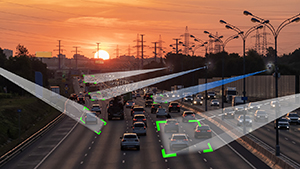
As technology continues to permeate every aspect of our lives, its impact on public sector procurement—particularly at the municipal level—is profound and far-reaching.
When it comes to procuring goods, municipalities everywhere have unique considerations that set them apart from other public sector groups making significant purchases. Cities and towns, which purchase everything from traffic equipment to construction materials, must abide by their own bylaws and procurement policies when reviewing tenders and evaluating bids. As stewards of taxpayer monies, transparency throughout the entire process is also key.
Fortunately, a wealth of new and developing technology is available to make procurement simpler, faster, and more efficient. The explosion of procurement portals, e-releases, and submissions, the increase in added-value components such as auto summaries, and the utilization of virtual meeting platforms such as Teams all work in tandem to speed up and improve the procurement process.
Transforming Procurement Processes

Traditionally bound by manual processes and paper trails, public sector procurement is undergoing a significant transformation.
“The implementation of new technologies is changing procurement processes at great speed,” explains Dan Munshaw, a municipal sector veteran and Business Development Advisor with OECM.
OECM, the trusted not-for-profit collaborative sourcing partner for Ontario’s public sector, leverages several advanced technologies, including e-procurement systems, cloud-based collaboration tools, data analytics, and more, in its sourcing processes to better support its customers, including a growing number from the municipal sector.
Munshaw, who notes that over 220 municipalities are currently leveraging OECM’s services, says that new technology has created shorter process cycle times, granted customers and partners faster access to large data pools and eliminated some outdated and more time-consuming tasks such as time clocks, sealed envelope receipts and in-person bid openings.

Deepali Vasisht, OECM’s Senior Manager, Strategic Sourcing, highlights e-Procurement systems and cloud-based collaboration tools as two key advancements that are revolutionizing the way municipalities handle procurements.
“e-Procurement systems simplify the procurement process by moving everything online, from tendering to contract management. This reduces paperwork, minimizes mistakes, and speeds up the entire process,” Vasisht says. “Cloud-based platforms facilitate real-time collaboration between internal and external stakeholders, improving communication, coordination, and transparency.”
Vasisht notes that in addition to cloud-based tools, artificial intelligence (AI) and machine learning (ML) are also rapidly being embraced to further simplify and speed up the procurement process. As these new technologies become more prevalent, they will play a crucial role in driving more informed and strategic procurement decisions across the public sector.

Emerging technologies, such as smart contracts and the Internet of Things (IoT), are also poised to change the way procurements are conducted in the near future. Vasisht explains that smart contracts are self-executing contracts with the terms of the agreement directly written into code. This automates compliance and payment processes, resulting in speedier transactions and less strain on a customer’s administrative team.
IoT, which many associate with advanced technology such as smart water meters, IoT-enabled traffic lights that adjust to real-time traffic conditions, and environmental sensors that collect real-time data on infrastructure and assets, allows for more efficient resource management and smarter procurement strategies designed according to actual usage and condition data.
New technology also provides customers and partners with more knowledge, as data analytics allows users to uncover patterns and glean insights – something that can help towns and cities negotiate better deals, identify risks, and improve supplier performance.
The Path Forward

Other emerging technological advancements revolutionizing the procurement process are e-tendering and digitization. E-tendering, for example, gives customers and suppliers a greater pool of partners to connect with and simplifies the procurement process by automating the issuing of invitations and receiving of bids. When suppliers can access tender documents and submit their bids online, speed, opportunity and transparency (because all actions are logged), are all increased, while manual work is reduced considerably.
Since the online ecosystem allows more suppliers to share their product availability with municipalities, the average number of bid submissions has doubled.
“Before, we could average two and a half bid submissions per procurement call; now, it’s closer to four, which means more choice, better pricing, and greater added value passed on to the customer,” says Munshaw. “There are national bids and international bids, and we never would have received those before.”
Digitization, part and parcel of conducting the procurement process online, offers a range of additional benefits. It reduces paperwork while making documents more accessible and allowing users to access specific data with greater immediacy. Digitization fosters deeper collaboration, as multiple stakeholders can connect in real time, facilitating faster decision-making. Munshaw also points out some unexpected benefits of digitization, noting that it results in “less office space required and significant cost savings from off-site storage of hard copy files.”
As a leader in the procurement space, OECM has been proactive in adopting several of these new and emerging technologies. Composed of dynamic professionals, OECM is committed to continuous learning and adopts a forward-thinking approach to exploring and utilizing emerging technology, thereby consistently improving its processes and helping deliver exceptional value to customers across all sectors.

Vasisht says OECM uses e-Tendering platforms, including the Ontario Tenders Portal (OTP), concurrently with platforms such as bids&tenders, Merx and Biddingo to further automate and streamline the tendering process. OECM has also digitized its approval workflows, moving away from paper-based processes to digital systems, including using MS Teams for approval workflows, integrating approvals through MS Dynamics, and using digital signature solutions like DocuSign. Also, OECM’s teams consistently leverage Business Intelligence (BI) and Data Analytics tools to analyze large amounts of data, decode procurement trends, predict procurement needs, optimize supplier selection, and help customers find cost savings. These innovations have streamlined OECM’s procurement processes, improved data management, and enhanced supplier collaboration, resulting in greater overall value for customers.
The integration of technology into municipal procurement is not just a trend but a necessity for future success. As technologies like AI, IoT, and smart contracts continue to evolve, municipalities that embrace these tools will be better positioned to navigate the rapidly changing procurement landscape.
As Vasisht emphasizes, “By embracing these technological advancements, municipalities can make their procurement processes more efficient, cost-effective, and transparent, ultimately delivering better services to their communities now and in the future.”
Stay tuned for part two of this series on technology in municipal procurement, where we will dive deeper into Artificial Intelligence (AI) and its impact on municipal procurement and share top tips for procurement professionals on harnessing the power of technology.
This article was published in the September 2024 issue of the Ontario Public Buyers Association (OPBA) Caveat Emptor E-News.
